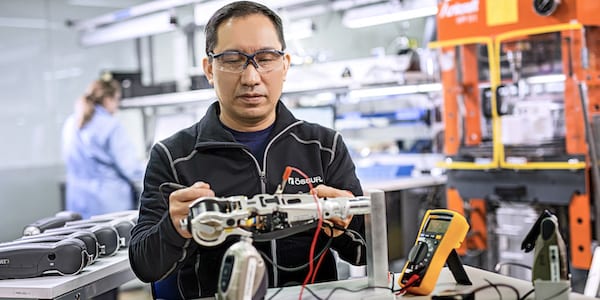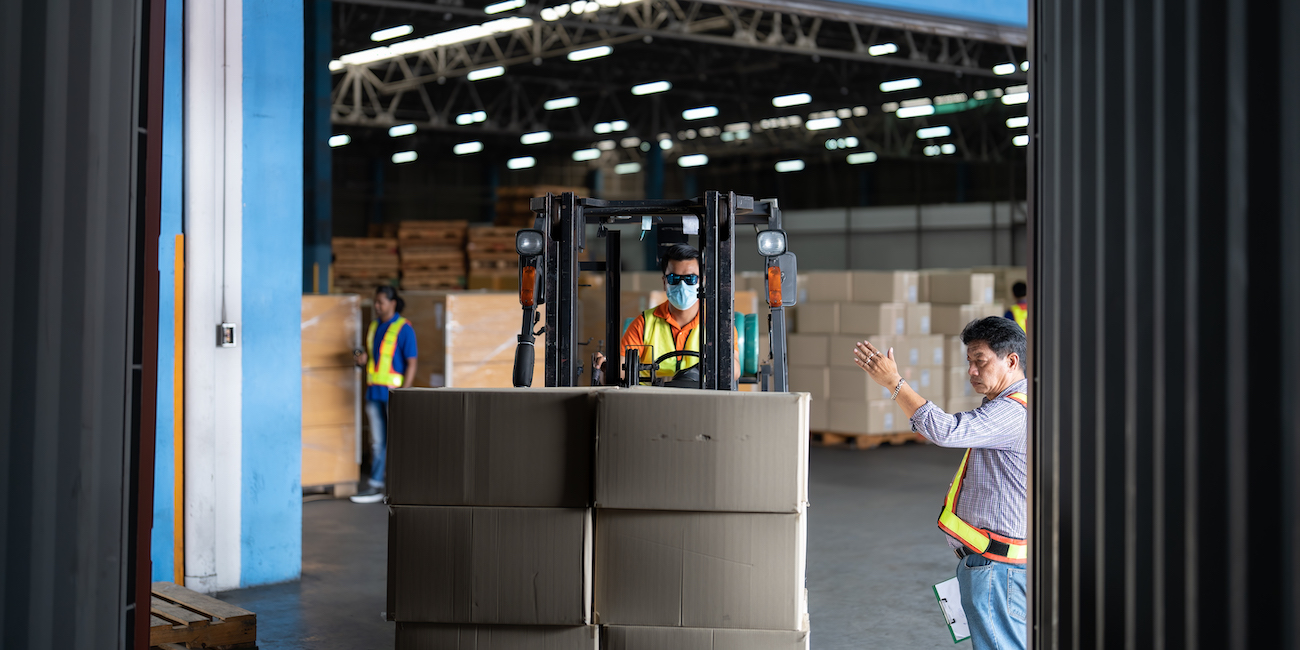
Prosthetics manufacturer uses lean thinking to stay on top
CASE STUDY - Össur is recognized as a leader in the fields of prosthetic, osteoarthritis and injury solutions, but how did lean management and a trial-and-error approach to improvement help it to stay competitive?
Words: Viktoría Jensdóttir, former continuous improvements and safety manager, Össur Iceland; Guðbjörg Sæunn Friðriksdóttir, Lean Process engineer, Össur Iceland
Personal stories by: Viktoría Jensdóttir
I once walked into our CNC area wearing particularly nice clothes and in high heels. I was on my way to a dinner party, but had to stop quickly by the office on my way there. It was just a few months after we had started to implement 5S in our manufacturing department, and I was really surprised, upon walking in, to see a big puddle of oil on the floor.
I remember walking up to the CNC operators and asking them about it. They looked at me blankly and gave me some bogus answer about the spill having been caused by people working the other shift. Isn't it always the other shift? I then said, "So, you are not going to clean it up?" When my question was again met with blank stares, I realized I only had two options: I could either go and pretend I hadn't seen the puddle - which would have sent the employees the message that tidiness doesn't matter - or I could just clean it up myself.
I chose option number 2. I clacked my way to the cupboard to grab a mop and some cloth, and proceeded to clean the floor. The CNC operators looked at me, big-eyed, and asked why I was cleaning. "Are there guests coming?" I chuckled and said that I just thought it was messy and that we could do better than that. "Don't you agree?" I concluded. They agreed. It is really important for leaders to lead by example, and we like to walk the talk at Össur.
It must be said that the puddle incident was actually one of few times we slipped in our 5S'ing efforts. Our CNC area was absolutely spotless – we called it "the tidiest CNC area in Europe" and we were all very proud of it – but in lean you can never let your guard down.
LEAN SUPPORTS INNOVATION
Our mission at Össur is to support a better quality of life for millions of people by improving their mobility. The company is known for the Symbionic Leg, the world's first complete bionic leg, and for other innovative products, such as the Unloader One dynamic brace or the unique Proprio Foot, the world's first intelligent prosthetic foot. This week, Össur announced the release of mind-controlled prostethic technology.
It is innovations like these that have shaped the ethos of our company since its very conception in the early 1970s, when founder and prominent Icelandic prosthesist, Össur Kristinsson, started to focus on the design of a better interface for prosthetic sockets. His work on a silicone socket solution produced the revolutionary Iceross silicone liner, which has helped amputees around the world to secure prostheses to limbs far more effectively and comfortably than had previously been possible.
Today, with Össur employing 2,300 people in 18 locations, it is that same desire to innovate and improve people's lives that drives everything we do. And there is no doubt that lean thinking is contributing greatly to our success: the quicker and better we are, the more time we have to focus on innovating.
THE JOURNEY BEGINS
Össur's lean journey began in 2005, when a group of senior managers went to Ireland for a benchmarking visit. While touring a company that had some great processes in place and seemed to be doing incredibly well, the team asked themselves, "What are they doing that we are not doing?" The answer was lean thinking. From that moment on, they started to gather information on the methodology, to attend conferences and read books, thinking about how it could work at Össur.
It wasn't until a few years later that they decided it was the right time to actually get started. They hired a consultant from the United States and organized two kaizen events in our Icelandic location, one in the carbon fiber department and one in the silicone prosthetic liner department. The results were asthonishing, especially in the first experiment, where the delivery time for a carbon foot was reduced from seven days to three.
At that point, leadership realized how great an impact lean could have on both the Icelandic and the global manufacturing operations of the organization and decided to invest more time and effort in applying its principles in all sites. The company was doing well, and had no burning platform per se – I just think the leadership team recognized lean was the next logical step.
As it often happens, the first (of a few) attempt was to implement 6s (later called "safety plus 5S").
THE 5S'ING BEGINS
Our first attempt at 5S failed slowly but surely.
Despite the team's extraordinary efforts, we did too many things too fast, and with no clear ownership. But it was incredible to see people so motivated and interested in learning and trying new things.
In 2010, lean champions were hired in the US, Iceland and the Netherlands and it was then that things started to go faster. It made a huge difference to have people with the vision and knowledge of where we could go as a company, and who had the time to actually work on it and help us to make it happen. That year more kaizens were completed and another attempt at 5S was carried out – with a new name, "safety + 5s."
This time we implemented 5S with the kaizen methodology, meaning that the operators were involved in every step of the process and really owned the system.
We also implemented standardized work and cleaning schedules, as well as weekly/montly audits. We also started to present those numbers to management to ensure that everyone knew how important this was.

VISUAL BOARDS AND DAILY HUDDLES
2011 was a very big year in our lean journey. We implemented visual boards and daily huddles in all departments in Iceland. We started slowly, by implementing a visual board in one of our departments, the CNC area. We found those metrics that were connected to the company's strategy and worked with supervisors and employees to influence them. After that we started daily meetings and coaching on the shop floor.
At first, daily meetings were only held if the process owner was there, because there was no clear understanding of why we were doing those meetings. We changed that by rotating who managed the daily meeting and by training more employees. Soon after we started to do quick morning market sessions, during which we would look at defects experienced on the last shift.
A few months later, in a bid to further boost engagement, we started to stretch together every day right after the meetings. Many people laughed at this unusual initiative, but most of the employees really liked it and it did help to get the team closer together.
The visual boards and daily meetings had not been in place for long before other departments started to ask for lean to be applied to their operations as well. The experiments expanded to the rest of the manufacturing department very quickly.
In 2011 we also started using the AME Lean Assessment to boost our efforts. We developed it further to match our needs and put in what specific behaviours we wanted to see in our people. By using this customized assessment tool, we could both have an idea of where we were at any given time compared to where we wanted to be and benchmark different Össur facilities.
Even though I really love the lean assessment, I must say you really need to be careful when using it because you don't want to be implementing certain tools just because some assessment method tells you to – you want to do it because it's the right thing for you and your company.
THE SAGA OF THE SUGGESTION SYSTEM
The obvious next step after the boards and meetings seemed to be getting suggestions from the employees, and making them visible.
We decided to start only in one department by running a few experiments: the first system we implemented was simple post-it notes on a quadrant (not started-started-on hold-rejected/done).
Unfortunately, it didn't work too well because employees were not sure what to put on the quadrant. There was no clear ownership of the system and anyone from outside the department who was called to help didn't know what to do. Additionally, the post-it notes kept falling off, and before long the whole initiative fell through. We realized that we couldn't do everything at once and decided to put the suggestion system on hold.
It wasn't until a year later that we implemented the current system, which is extremely simple but still took some time to develop. Along the way, we had to answer a number of questions, like "What works with our culture and values?" and, within that, "Should we select the best idea and reward it, or simply reward people's attempt to participate?"
Some people even said that it didn't fit our culture (both organizational and national) at all to have a suggestion system, but we wanted to make sure everyone was engaged and to be able to reward good ideas while having a clear overview of our current state. In the end, we decided to try out a rewards lottery: every month we drew a certain amount of ideas out of a pot for each area and rewarded them. Later on, this evolved into an evaluation of the best idea because supervisors wanted to reward the best suggestion for its potential contribution to the business rather than simply recognize a random one just to encourage more people to engage.
Under the current system, employees come up with a suggestion, talk to their supervisor and fill out a form. They should then receive an approval or a rejection. If approved, the suggestion is finally implemented (and put into our sharepoint system, so we have a clear view of how departments are doing).
We started with a goal of implementing five ideas per employee, and later went to seven. We have also dabbled with creating a visual board with ideas so that employees have a clearer understanding and with having visual kanbans for ideas in place. This year's goal is to reach the 1,000 ideas implemented mark. We also plan to measure the number of suggestions that are not implemented and determine where and when they stop in the system.

THE IMPROVEMENTS
Since 2009 we have completed a large number of kaizens, trying to involve as many employees as possible in our efforts.
As mentioned earlier, we started with 5S and moving things around (we used spaghetti diagrams all the time) to come up with an organization of the workplace that made sense. We also identified the need for quicker changeovers, which we achieved using the SMED technique. It was very funny to see the set-up guys watch themselves in the videos we took to help everybody understand where mistakes were made and improvement was possible. We kept hearing comments like, "I can't believe I do that" or "That could not have been a regular day!" It was eye opening for them to do that kind of exercise.
We also introduced a number of visual management improvements. For example, we marked what was on inventory using different colors, so that employees could spot where each material was faster and easily.
I remember one visual tool that we implemented and that the CNC operators really wanted in order to have it clearly marked whether a machine was running or if it was down for maintenance or for a breakage. Again, the idea was to use different color tags on the machines and then ask the operators to switch tags when the status of the machine changed. I was very hesitant because we had tried this sort of thing in the past and it had failed. But I didn't want to go against people, because they seemed to feel really strong about it – I am happy to report that I was wrong. The system worked perfectly and is still in use today.
The changes were not limited to the manufacturing department. In the product development area, engineers were involved earlier in the process so that they can determine early on what will work or won't work once the product is manufactured. This of course makes a huge difference.
But the biggest change is in the mentality of people, who now think - and know - that we can always do better. Their involvement has grown significantly since we introduced lean thinking. I believe that people are realizing how much kaizen has changed us as an organization, and love what they see. After our first kaizen, for example, one employee told me "I love kaizen, because you listen to me" – reminding how in the past it had happened to her that the department had been refurbished and completely altered overnight with no operator involved. Today Össur is a better company.
NEXT STEPS
There is still a lot to do. In many ways, our journey has only just begun. Going forward we plan to, for example, make our gemba walks a bit more structured in all departments: supervisors and process owners will walk their processes together with an eye on the improvements and to listen to the workers. The production manager will also do this at least once a month.
We are also trying to get better at strategy deployment: this year the A3s will be updated monthly rather than quarterly, because we recognize the importance for supervisors and process owners to go through the SQDC goals with the employees.
We will keep stabilizing our understanding and use of lean tools and application of lean principles, but there is no doubt whatsoever that Össur's lean efforts will continue in earnest.
THE AUTHORS


Read more


WOMACK'S YOKOTEN – As the Lean Enterprise Institute turns 20, its founder provides us with a bit of hansei on where we are and where we are going next as a community, and on what challenges we might tackle.


FEATURE – How can digital companies develop a competitive edge in the "tech first" future? By using Lean Thinking to ensure continuous learning and transform the way coders think and work.


FEATURE – There is more to logistics than an ancillary process that supports the rest of the company. But then, why do we never have a plan for it, like we do for manufacturing?


INTERVIEW – Mike Hoseus reflects on his time at Toyota and on how the respect for people side of lean thinking is too often neglected and we tend to focus on continuous improvement only. The two must go together, or your house will collapse.

